Court deadlines aren’t flexible. Budgets rarely are either. And yet, some legal teams consistently deliver complex matters with speed, clarity, and control. What’s going on behind the scenes?
How legal companies approach project management may not look like what you'd expect, but the strategies driving top-performing firms are anything but traditional.
In this article, we will:
- Master legal project delivery with this 7-step system
- Understand who owns what in legal project teams
- Enable mid-sized firms to systemize legal delivery
Legal Project Management Mastery: The Complete 7-Step System
Legal companies have revolutionized case delivery through systematic project management. Today's leading firms follow a 7-step strategic framework that ensures on-time, on-budget results while exceeding client expectations.
Step 1: Initial Project Scoping and Goal Setting
Every successful legal project starts with crystal-clear objectives and defined boundaries.
- Client consultation process - Thorough initial meetings to understand needs and business context
- Scope definition methodology - Structured intake forms defining deliverables, timelines, and budgets
- Stakeholder identification - Mapping all internal and external parties involved
- Goal establishment - Setting SMART objectives for each legal matter
- Documentation requirements - Written project charters recording scope and success criteria
The foundation phase determines project success or failure. Leading legal companies invest significant time upfront to prevent costly misunderstandings later. They use structured consultation processes that go beyond surface-level requests to uncover underlying business objectives.
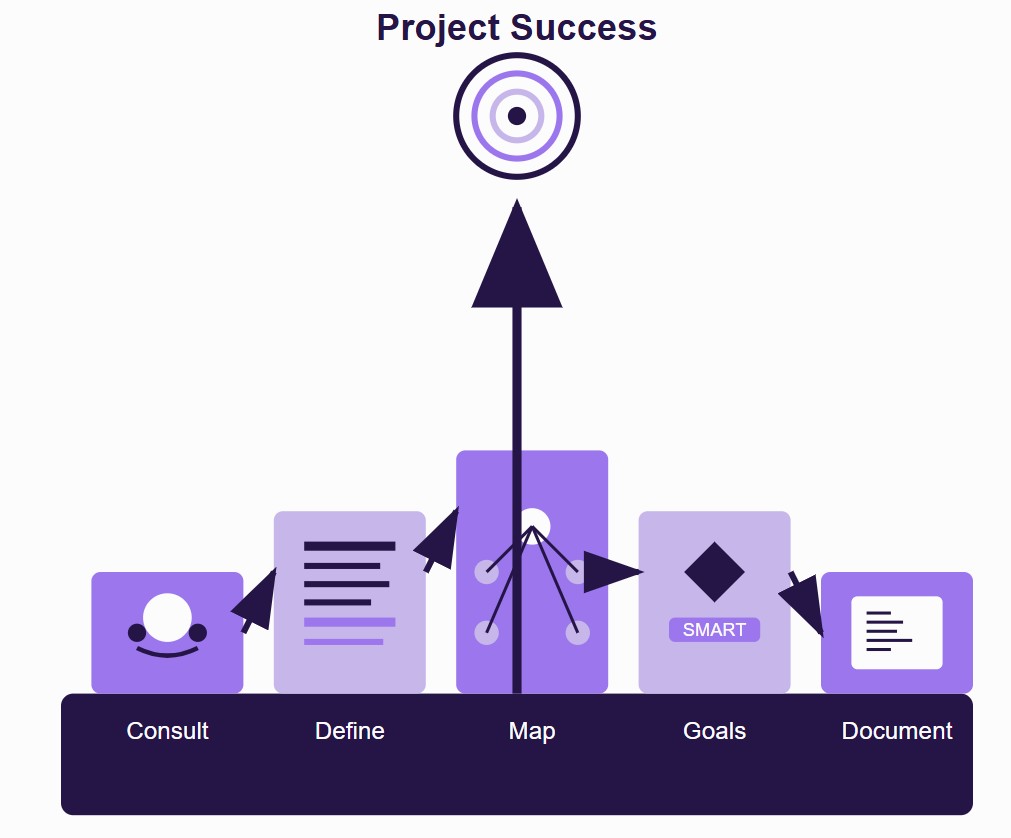
Smart firms create detailed project charters that serve as the North Star throughout the engagement. These documents eliminate scope creep by clearly defining what's included and excluded, establishing measurable success criteria, and creating accountability structures that keep everyone aligned.
Step 2: Strategic Planning and Resource Allocation
Comprehensive planning transforms complex legal work into manageable, coordinated workflows.
- Project plan development - Roadmaps outlining tasks, dependencies, and critical path activities
- Resource assignment - Skill-based matching of team members to project requirements
- Budget planning - Detailed cost breakdowns and fee arrangement structures
- Timeline creation - Realistic schedules with buffer time and deadline considerations
- Risk assessment - Upfront analysis of potential challenges and mitigation strategies
Strategic planning separates elite firms from the competition. Top performers create comprehensive roadmaps that account for every significant task, identify critical dependencies, and establish clear milestones that demonstrate progress.
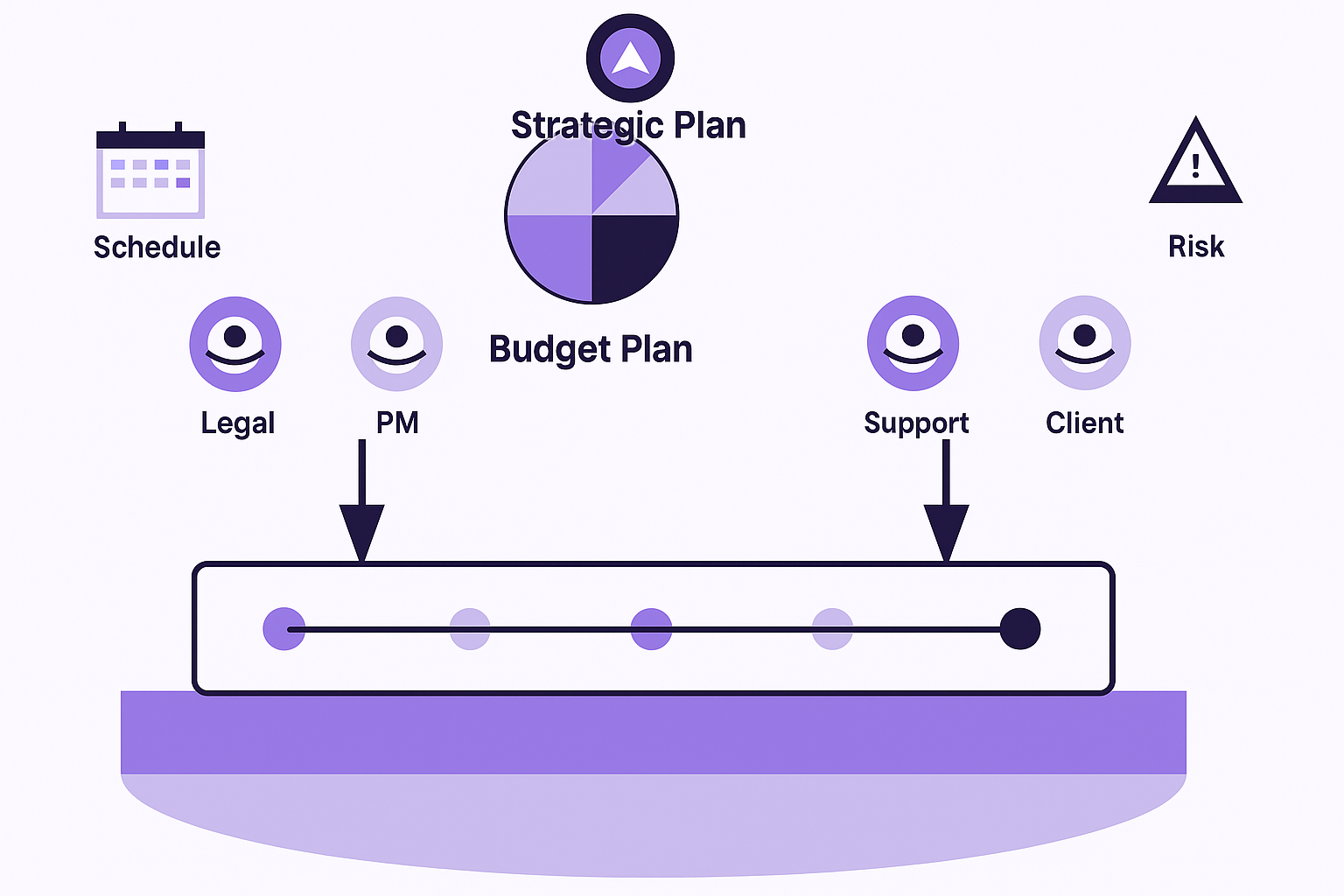
Modern resource allocation uses sophisticated matching algorithms that consider expertise, workload capacity, and cost efficiency. This systematic approach ensures the right people work on the right tasks at optimal utilization rates.
Step 3: Technology Integration and Tool Selection
Digital infrastructure enables unprecedented efficiency and transparency in legal project delivery.
- Legal PM software implementation - Specialized platforms integrating with existing systems
- Workflow automation - Automated task assignments and deadline reminders
- Document management - Centralized repositories with version control and security
- Communication platforms - Collaboration tools for teams and client communication
- Reporting dashboards - Real-time visibility into project status and budgets
Technology has become a great differentiator in legal project management. Leading firms deploy specialized platforms that eliminate data silos and create unified digital ecosystems.
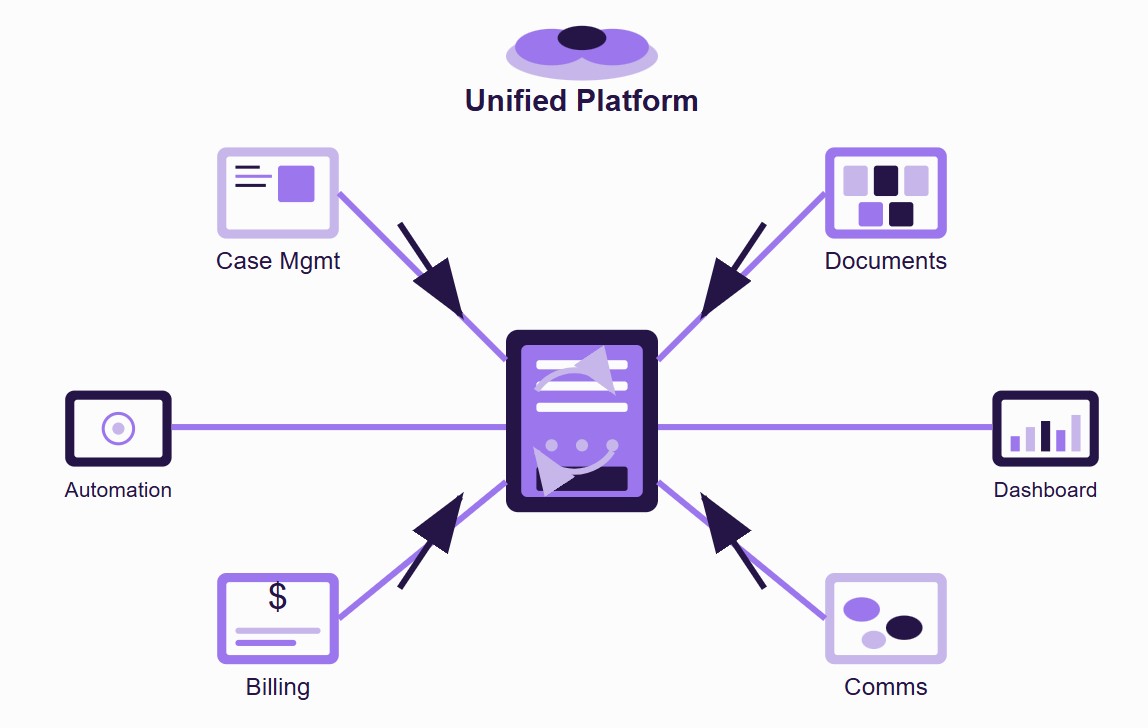
Smart automation eliminates routine administrative tasks that consume valuable attorney time. Automated systems handle task assignments, send deadline reminders, and provide escalation alerts when projects fall behind schedule or exceed budget thresholds.
Step 4: Execution and Ongoing Management
Disciplined operational rhythms maintain project momentum and prevent small issues from becoming major problems.
- Daily operational workflows - Brief standups tracking progress, and identifying obstacles
- Milestone monitoring - Formal reviews with comprehensive progress assessment
- Budget tracking - Weekly variance reports and early warning systems
- Change management - Formal processes for scope changes and approvals
- Quality control - Review checkpoints with senior oversight and client feedback
Even the best plans require disciplined execution. Leading legal companies implement daily operational rhythms that keep projects moving forward efficiently through brief check-ins and continuous monitoring.
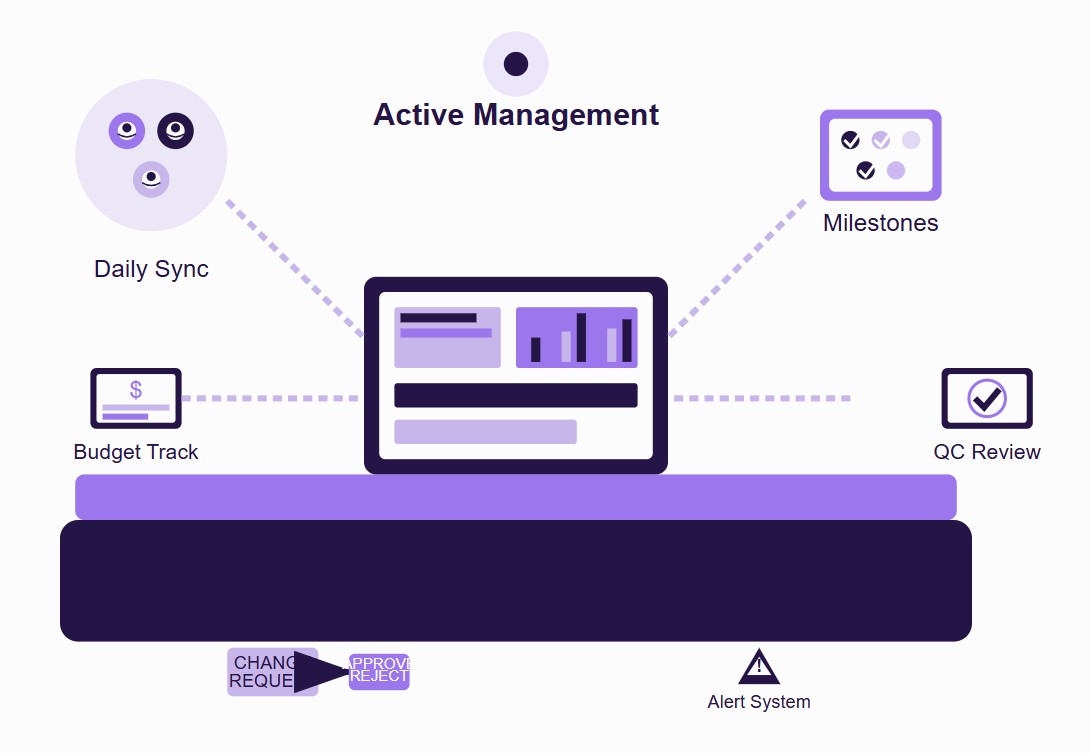
Milestone reviews serve as crucial decision points throughout the project lifecycle. These formal assessments ensure work quality meets standards, timelines remain realistic, and budgets stay on track.
Step 5: Communication and Stakeholder Management
Transparent engagement builds trust and ensures alignment throughout complex legal matters.
- Regular reporting - Scheduled updates with weekly emails and monthly dashboards
- Escalation procedures - Clear protocols for raising issues to decision-makers
- Client collaboration - Ongoing dialogue and feedback integration
- Internal coordination - Seamless collaboration between teams and external counsel
- Transparency maintenance - Real-time project status through client portals
Communication failures sink more legal projects than any other factor. Smart firms develop sophisticated stakeholder management strategies that eliminate uncertainty and build confidence through predictable communication schedules.
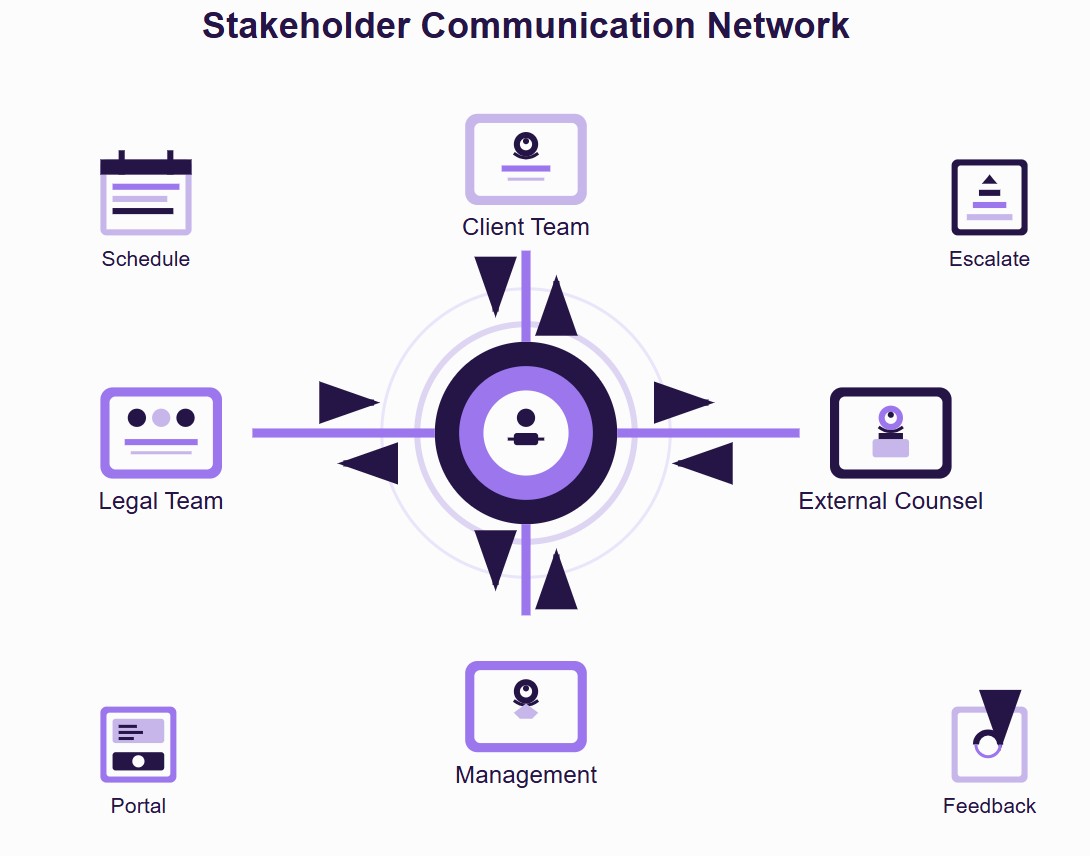
Modern clients expect real-time access to project information. Top firms maintain open books policies and provide detailed cost and timeline information that demonstrates value and builds trust.
Step 6: Performance Measurement and Evaluation
Systematic evaluation and learning drive continuous improvement and competitive advantage.
- Success metrics tracking - KPIs including schedule adherence and client satisfaction
- Outcome analysis - Comprehensive evaluation against original objectives
- Lessons learned documentation - Post-project reviews identifying improvements
- Process refinement - Updates to templates and workflows based on experience
- Knowledge transfer - Archived insights for future similar matters
What separates good legal companies from great ones is their commitment to systematic performance evaluation. Leading firms monitor key performance indicators that matter most to clients and business success.
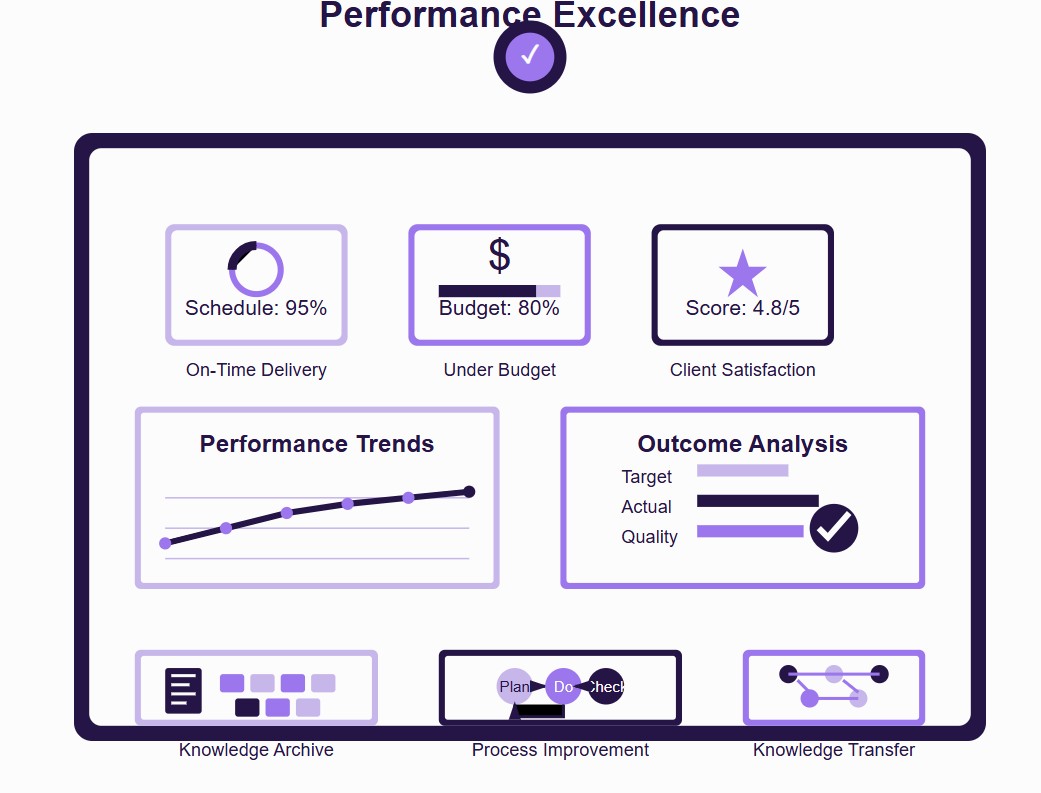
Institutional learning requires systematic knowledge capture. Smart firms conduct comprehensive post-project reviews, document improvement opportunities in searchable databases, and create mentoring programs that transfer expertise across the organization.
Step 7: Continuous Improvement and Innovation
Relentless improvement and innovation maintain a competitive edge in rapidly evolving legal markets.
- Monthly team reviews - Regular sessions discussing successes and areas for improvement
- Client feedback integration - Systematic collection and analysis of client input
- Technology upgrades - Regular evaluation of new tools and platforms
- Training and development - Investment in team capabilities and methodologies
- Competitive differentiation - Using PM excellence as a marketing advantage
The legal industry evolves rapidly, and firms must commit to continuous enhancement to maintain their competitive position. Leading firms create cultures of improvement through regular team reviews and innovation initiatives.
Legal companies that master these approaches don't just survive in today's competitive environment - they thrive, building sustainable practices that attract the best clients, retain top talent, and generate superior financial performance.
Who Does What: Key Roles in Legal Project Management Teams Explained
Legal project management is not a solo act - it's a cross-functional collaboration between legal, operations, and administrative professionals. Each role contributes specific expertise to ensure that legal matters are delivered on time, within budget, and aligned with client expectations.
Here’s a breakdown of the core roles and how they interact:
Legal Project Manager (LPM)
The Legal Project Manager is the operational quarterback of the legal matter.
- Main Focus: Planning, execution, and monitoring of legal projects
- Responsibilities:
- Develop project plans and timelines
- Track budgets and deliverables
- Facilitate communication among legal teams and clients
- Manage scope changes and risk mitigation
- Key Strength: Brings project management expertise (PMP, Agile, Lean) into the legal environment
Think of them as the glue between attorneys, finance, and the client, ensuring accountability, predictability, and transparency.
Legal Operations Manager
The Legal Ops Manager drives efficiency and scalability across the legal department or firm.
- Main Focus: Process improvement, technology optimization, vendor and resource management
- Responsibilities:
- Select and implement legal tech (CLM, billing, dashboards)
- Standardize workflows across legal teams
- Analyze cost structures and matter performance
- Handle vendor and external counsel relationships
- Key Strength: Strategic enablement and internal consulting mindset
They set up the systems that allow LPMs and attorneys to execute more effectively.
Managing Partner or Practice Lead
This is the executive authority in legal matters, often balancing legal acumen with firm-wide strategic goals.
- Main Focus: Legal oversight, client relationship management, and high-stakes decision-making
- Responsibilities:
- Approve legal strategies and resource allocation
- Lead key client relationships
- Ensure legal quality and regulatory compliance
- Escalate or resolve project-level risks
- Key Strength: Legal expertise + leadership authority
They are the ultimate decision-makers and champions of the firm's reputation and legal outcomes.
Paralegals and Legal Analysts
These professionals handle the nuts and bolts of legal execution.
- Main Focus: Day-to-day legal tasks that support the case or transaction
- Responsibilities:
- Conduct legal research and document review
- Manage case files and discovery materials
- Prepare drafts and filings
- Update task statuses in PM tools
- Key Strength: Deep familiarity with legal documentation and workflow precision
They are the task-level executors that keep things moving under LPM coordination.
Sample RACI Matrix for a Legal Project (e.g., M&A Transaction)
Legend:
- R = Responsible
- A = Accountable
- C = Consulted
- I = Informed
The investment in building a proper legal project management team structure pays dividends in improved client relationships, enhanced profitability, and sustainable competitive advantage in an increasingly sophisticated legal marketplace.
Smart Legal PM on a Shoestring: How Mid-Sized Firms Win Without Big Budgets
You don't need BigLaw resources to achieve BigLaw results. Mid-sized law firms often get caught in the middle—too large for simple spreadsheets but lacking the budget for enterprise solutions. Strategic, budget-conscious implementation can deliver 80% of the benefits at 20% of the cost.

Start Where You Are: Email + Excel Foundation
Before investing in specialized software, optimize what you already have. Transform your existing tools into a project command center:
Email Organization:
- Client-Matter-Date naming: "ABC Corp - M&A - 2025-06-15 - Document Review"
- Standardized subject lines: "[ACTION REQUIRED]", "[UPDATE]", "[DEADLINE: MM/DD]"
- Email templates for status updates and deadline reminders
Excel Project Tracking:
- Master project tracker with conditional formatting for deadline alerts
- Drop-down menus for standardized status updates
- Automatic budget variance calculations using simple formulas
Cost savings: $0 investment, immediate 40% improvement in project visibility
Smart Staffing: Maximize Human Resources
Create project management responsibilities within existing positions:
Senior Paralegals as Project Coordinators:
- Natural oversight skills from case management experience
- Training investment: 20-30 hours of PM fundamentals
- Additional compensation: $3,000-5,000 annually
Associates as Matter Managers:
- Business skills development beyond legal analysis
- Client relationship building opportunities
- Billable project management time at associate rates
PM-savvy paralegals often make exceptional project managers because they already understand legal deadlines, document workflows, and client confidentiality requirements.
Budget-Smart Technology Solutions
Choose tools that provide maximum value with minimal learning curves and budget impact.
Free Option: Trello
- Visual Kanban boards perfect for legal workflows
- Free tier: Unlimited boards for up to 10 team members
- Legal adaptation: To Do → In Progress → Client Review → Complete
- Setup time: 2-3 hours firm-wide
- Learning curve: Minimal—productive within 1 week
Low-Cost Professional: ClickUp
- $7/user/month for comprehensive features
- Includes: Gantt charts, time tracking, automation, reporting
- ROI: Often pays for itself within 60 days
- Scalability: Grows from 5 to 50+ team members
AI-Powered: Dart
- Free tier available for small teams
- Pro plan: $8-10/month per user
- AI advantages:
- Automatic task generation and subtask creation
- Smart property filling and categorization
- AI-powered reporting for client updates
- AI teammate functionality that executes writing tasks
Dart saves teams 7 hours per week in administrative tasks through intelligent automation.
Implementation Strategy
Phased approach ensures smooth adoption while demonstrating value at each milestone.
Phase 1 (Months 1-2):
- Start with free Trello for basic visualization
- Implement email and Excel optimizations
- Train 2-3 power users as internal advocates
Phase 2 (Months 3-4):
- Upgrade to ClickUp or Dart based on needs
- Expand to additional practice areas
- Begin measuring ROI through time savings
Phase 3 (Months 5-6):
- Advanced feature implementation
- Custom workflow development
- Performance metrics analysis
Measuring Success
Track meaningful metrics using simple methods:
- Project completion time before vs. after implementation
- Budget variance percentage and missed deadline frequency
- Client satisfaction scores (simple 1-10 surveys)
- Team overtime reduction and efficiency improvements
Use free tools: Google Forms for surveys, built-in tool analytics, and Excel formulas for variance reports.
Bridge Legal Expertise With Operational Precision
Project management is no longer a luxury - it’s a legal necessity. Whether you're a BigLaw giant or a mid-sized firm, operational discipline unlocks faster delivery, better margins, and happier clients.
From structured scoping to real-time dashboards and an AI-powered project management software for law firms like Dart’s, the roadmap is clear: embed precision into every matter. Start small, scale smart, and treat legal project management as your firm's next competitive edge.


.png)
_light%201.png)





